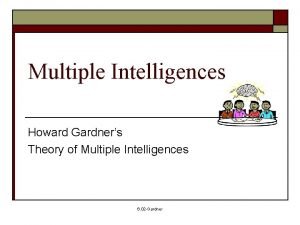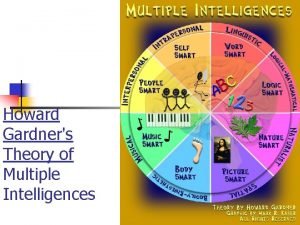Howard Gardners Theory of Multiple Intelligences Gardners theory

- Slides: 1

Howard Gardner’s Theory of Multiple Intelligences Gardner’s theory suggests that each human being have individualized frameworks for understanding and engaging in the world around them. Identifying these frameworks and strengths is important in social work practice as we will work with a variety of people in different life stages with different capacities and perceptions. How can Gardner’s theory of Multiple Intelligences be applied in the context of a homeless shelter? Maslow & Gardner: Examples of development in a homeless shelter By Kelsi Babin, September 10 th 2014, Sow 637 Human Behviour in the Environment, Faculty of Social Work, University of Calgary Abstract The human lifespan does not have an episode of change and development, from early childhood to late adulthood human beings are constantly changing and developing in physiological, emotional, cognitive and social manners. Social, cultural and political environments play a role in one’s development, including homeless shelters. How can we apply theories of human development such as Abraham Maslow's’ ‘Hierarchy of Needs’ and Howard Garner’s theory of ‘Multiple Intelligences’ to create in homeless shelters an environment that fosters human development? Why is it important to understand the stages of human development from a social work lens? Human development Prenatal Development and Birth: emphasized changes Human beings at all stages of development from conception to death have include development of sex, different perceptions and levels of understanding and engaging with the physiological changes in world. Each unique stage of development a human being experiences call forming the body and brain as for different needs, approaches and services. It is important in social work well as birth. Everybody is a Genius. But If You Judge to understand the lifespan differences in needs and capacities of each Infancy and Early Childhood : a Fish by Its Ability to Climb a Tree, It individual in order to anticipate and serve them in a custom manner emphasized changes in this Will Live Its Whole Life Believing that It (Boylan, 2012). For example, a social worker would not treat a child client stage includes: development is Stupid. – Albert Einstein in the same capacity as an elderly client or adult client. It is important for of motor skills, sensory skills, practitioners who work with a variety of individuals and groups through all perception, language stages of the life cycle to understand the different needs and capacities of development, personality and each stage of development in their appropriate cultural, political and socio- self-concept, attachment, economic landscape. relationships and gender development. How does the work of Gardner and Maslow influence your perception Middle Childhood and on human development? Adolescence: this stage emphasizes the development Gardner’s theory of ‘Multiple Intelligences’ has dramatically shifted my perception on human development. Throughout my late adolescent years I changes of learning, puberty, sexual behaviour, memory and noticed that my capacity for language arts learning increased, while my thinking. abilities in math and sciences (logic intelligence) was great diminishing Early and Middle Adulthood: In working with clients at the Main Street with my disproportionate interest for languages and arts. I thought my intimate relationships, Emergency Shelter and Detox Unit (Winnipeg, performances in the logic courses were a direct reflect on my personal parenthood, choosing an MB) I found that talents, happiness and social intelligence. However, I understand with Gardner’s theory that I have occupation, gender, aging. interactions were at a peak during the daily stronger skills in languages, reading comprehension, sociology, activities. These activities included karaoke, intercultural competency and interpersonal connections. With this idea in Late Adulthood and the End of Life: biological aging, arts and crafts, story-telling and more, high in mind I can develop my own strategies in my future practice to engage program and therapeutic content. It is with individuals and groups of different capacities and at various stages of cognitive changes, social observable that clients with stress and other development. With the findings I would be able to best tailor my services changes in relationships, cognitive changes such as effects of poverty understand engage with to a particular client according to their ‘intelligences’ or strengths and memory, wisdom and programs much better when it is delivered in a interests. Without doing so this client may be at risk for many ripple creativity and more. (Boyd, variety of methods in multiple intelligences. effect consequences in their education, health services and self-esteem. Johnson, Bee, 2009) References Anderson, B. (2012, July 18). Hunger and the Hierarchy of needs. Retrieved September 3, 2014, from http: //texashunger. wordpress. com/2012/07/18/hunger-and-thehierarchy-of-needs-2/ Interact. (2014, January 1). Multiple Intelligences. Retrieved September 7, 2014, from http: //interactschools. com/ Boylan, D. (2012). Curriculum Guide: Human growth and development. The College of Social Work, 1 -2. Hayden, K. (2012). Gardner's Eight Multiple Intelligences in the Classroom. Bright Hub Education, Teaching methods, 1 -2. Retrieved September 7, 2014. Abraham Maslow’s ‘Hierarchy of Needs’ Needs The hierarchy of needs is essentially a man of human development leading to the highest purpose of human existence, namely selfactualization. The bottom needs of the hierarchy are considered by Maslow to be ‘deficiency motives’; needs that aren’t met in these categories block development from attaining the next level of the hierarchy (Boyd, Johnson, Bee, 2009). These include physiological needs at the bottom, safety needs, love or sense of belonging and esteem. Finally, at the top of Maslow's’ hierarchy is the need for selfactualization; a need that can be attained only after all needs below are met. This is described as a state of well-being, realizing one’s potential and homeostasis or inner balance (Boyd, Johnson, Bee, 2009). It seems in life, we may jump categories in this hierarchy. Another factor that influences our life course on this chart is our stage in human development. For example, children will be concerned with meeting their physiological and safety needs. Adults that have established a secure environment that meets their bottom three needs categories may seek belonging, self-esteem or be working on self-actualization. However, life circumstances change dramatically over the life span, for example an illness, a change of city or country or homelessness. What a man can be, he must be. This need we call Self. Actualization – Abraham Maslow Discussion questions Can these theories be applied to all cultural, political and religious contexts? How does this hierarchy become affected in a region of chronic conflict or oppression? Can one become self-actualized even without meeting all other needs? How does this blanket hierarchy apply differently to all peoples (gender, ability, nationality, age etc. )? Applying this theory to the emergency shelter and detox unit, many homeless were relocated into housing projects far away from the shelter to help cover their basic housing needs in order to facilitate future employment, well-being and self-sufficiency. Over time, all except one came back to the shelter by choice. The common theme between the returnees was theme of security and belongingness they felt in the shelter and street community. Many felt that even with a home of their own, their safety needs were unmet because they were accustomed to pockets of known people at all times. Also this housing program did not meet their needs for Maslow’s category of love and belonging; they were scattered into different small apartments in communities they did not know. Without love and belonging, Maslow’s hierarchy suggests that selfesteem and self-actualization cannot be met. This theory contextualizes why most participants in the program came back to the streets to meet their basic needs.

